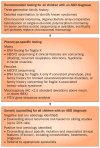Disentangling the heterogeneity of autism spectrum disorder through genetic findings
- PMID: 24468882
- PMCID: PMC4125617
- DOI: 10.1038/nrneurol.2013.278
Disentangling the heterogeneity of autism spectrum disorder through genetic findings
Abstract
Autism spectrum disorder (ASD) represents a heterogeneous group of disorders, which presents a substantial challenge to diagnosis and treatment. Over the past decade, considerable progress has been made in the identification of genetic risk factors for ASD that define specific mechanisms and pathways underlying the associated behavioural deficits. In this Review, we discuss how some of the latest advances in the genetics of ASD have facilitated parsing of the phenotypic heterogeneity of this disorder. We argue that only through such advances will we begin to define endophenotypes that can benefit from targeted, hypothesis-driven treatments. We review the latest technologies used to identify and characterize the genetics underlying ASD and then consider three themes-single-gene disorders, the gender bias in ASD, and the genetics of neurological comorbidities-that highlight ways in which we can use genetics to define the many phenotypes within the autism spectrum. We also present current clinical guidelines for genetic testing in ASD and their implications for prognosis and treatment.
Conflict of interest statement
The authors declare no competing interests.
Figures



References
-
- American Psychiatric Association. Diagnostic and Statistical Manual of Mental Disorders. 5. American Psychiatric Association; 2013. (DSM-5)
-
- Geschwind DH, Levitt P. Autism spectrum disorders: developmental disconnection syndromes. Curr Opin Neurobiol. 2007;17:103–111. - PubMed
-
- Hus V, Pickles A, Cook EH, Jr, Risi S, Lord C. Using the autism diagnostic interview—revised to increase phenotypic homogeneity in genetic studies of autism. Biol Psychiatry. 2007;61:438–448. - PubMed
-
- Anderson DK, et al. Patterns of growth in verbal abilities among children with autism spectrum disorder. J Consult Clin Psychol. 2007;75:594–604. - PubMed
-
- Burrell RA, McGranahan N, Bartek J, Swanton C. The causes and consequences of genetic heterogeneity in cancer evolution. Nature. 2013;501:338–345. - PubMed
Publication types
MeSH terms
Substances
Grants and funding
LinkOut - more resources
Full Text Sources
Other Literature Sources
Molecular Biology Databases
Miscellaneous

